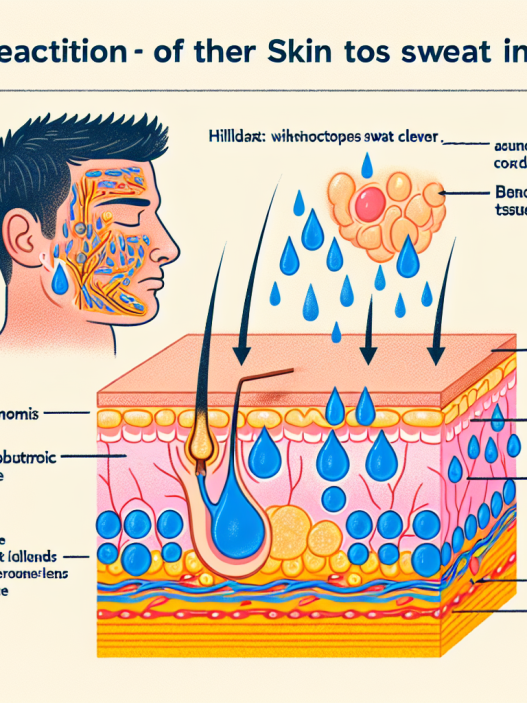-
Table of Contents
«¡Tirzepatide: la solución para combatir la fatiga crónica!»
Introduction
Tirzepatide es un medicamento que se ha utilizado para tratar la diabetes tipo 2, pero recientemente ha surgido interés en su posible efecto en la fatiga crónica. En este artículo, exploraremos la evidencia actual sobre si tirzepatide puede ayudar a reducir la fatiga crónica.
The Potential Benefits of Tirzepatide in Reducing Chronic Fatigue
Chronic fatigue is a debilitating condition that affects millions of people worldwide. It is characterized by persistent and unexplained fatigue that can significantly impact a person’s daily life. While there are various treatments available for chronic fatigue, they often provide limited relief and come with unwanted side effects. However, a new drug called tirzepatide has shown promising results in reducing chronic fatigue.
Tirzepatide is a medication that is currently being studied for its potential benefits in treating various health conditions, including chronic fatigue. It belongs to a class of drugs called glucagon-like peptide-1 receptor agonists (GLP-1 RAs), which are commonly used to treat type 2 diabetes. However, recent studies have shown that tirzepatide may have additional benefits beyond its primary use.
One of the main ways tirzepatide may help reduce chronic fatigue is by improving insulin sensitivity. Insulin is a hormone that helps regulate blood sugar levels, and people with chronic fatigue often have insulin resistance, which means their cells do not respond properly to insulin. This can lead to high blood sugar levels, which can cause fatigue and other symptoms. Tirzepatide works by increasing the body’s sensitivity to insulin, which can help regulate blood sugar levels and reduce fatigue.
In addition to improving insulin sensitivity, tirzepatide may also have a direct impact on the brain. Studies have shown that GLP-1 RAs, including tirzepatide, can cross the blood-brain barrier and affect the brain’s reward system. This system is responsible for regulating motivation, pleasure, and fatigue. By targeting this system, tirzepatide may help reduce chronic fatigue and improve overall well-being.
Furthermore, tirzepatide may also have anti-inflammatory effects, which can be beneficial for people with chronic fatigue. Inflammation is a natural response of the body to injury or infection, but chronic inflammation can lead to various health problems, including fatigue. Tirzepatide has been shown to reduce markers of inflammation in the body, which may help alleviate fatigue and other symptoms associated with chronic inflammation.
Another potential benefit of tirzepatide in reducing chronic fatigue is its effect on weight loss. Obesity is a common risk factor for chronic fatigue, and many people with this condition struggle with weight management. Tirzepatide has been shown to promote weight loss by reducing appetite and increasing feelings of fullness. This can be especially beneficial for people with chronic fatigue, as excess weight can further exacerbate their symptoms.
Moreover, tirzepatide may also improve sleep quality, which is crucial for managing chronic fatigue. Studies have shown that GLP-1 RAs can improve sleep patterns and reduce sleep disturbances. This is significant because people with chronic fatigue often experience disrupted sleep, which can worsen their symptoms. By promoting better sleep, tirzepatide may help reduce fatigue and improve overall quality of life.
While the potential benefits of tirzepatide in reducing chronic fatigue are promising, it is essential to note that more research is needed to fully understand its effects. Currently, tirzepatide is still in the clinical trial phase, and it has not yet been approved for the treatment of chronic fatigue. However, the initial results are encouraging, and many experts believe that tirzepatide may be a game-changer in managing this debilitating condition.
In conclusion, chronic fatigue is a complex and challenging condition to manage, but tirzepatide may offer a new ray of hope for those suffering from it. By improving insulin sensitivity, targeting the brain’s reward system, reducing inflammation, promoting weight loss, and improving sleep quality, tirzepatide has the potential to significantly reduce chronic fatigue and improve overall well-being. While more research is needed, the initial findings are promising, and many people are eagerly awaiting the approval of this new drug.
Understanding the Mechanism of Action of Tirzepatide in Managing Chronic Fatigue
Chronic fatigue is a debilitating condition that affects millions of people worldwide. It is characterized by persistent and unexplained fatigue that is not relieved by rest or sleep. This condition can significantly impact a person’s quality of life, making it difficult to perform daily tasks and participate in activities they once enjoyed. While there is no known cure for chronic fatigue, there are various treatment options available to manage its symptoms. One such treatment that has gained attention in recent years is tirzepatide.
Tirzepatide is a novel medication that has shown promising results in managing chronic fatigue. It belongs to a class of drugs called glucagon-like peptide-1 (GLP-1) receptor agonists, which are commonly used to treat type 2 diabetes. However, recent studies have shown that tirzepatide may also have a beneficial effect on chronic fatigue.
To understand how tirzepatide works in managing chronic fatigue, we must first understand the mechanism of action of this medication. Tirzepatide works by mimicking the action of a hormone called GLP-1 in the body. GLP-1 is naturally produced in the gut and plays a crucial role in regulating blood sugar levels. It also has other effects, such as slowing down the emptying of the stomach and reducing appetite.
In people with type 2 diabetes, GLP-1 levels are often low, leading to high blood sugar levels. Tirzepatide works by activating GLP-1 receptors in the body, which helps to lower blood sugar levels and improve insulin sensitivity. This mechanism of action has been well-studied and proven to be effective in managing diabetes. However, researchers have also discovered that tirzepatide may have additional benefits in managing chronic fatigue.
One of the proposed mechanisms of action of tirzepatide in managing chronic fatigue is through its effect on the brain. Studies have shown that GLP-1 receptors are also present in the brain, particularly in areas that regulate mood and energy levels. By activating these receptors, tirzepatide may help to improve the communication between brain cells, leading to a reduction in fatigue and an increase in energy levels.
Another proposed mechanism of action is through the regulation of inflammation in the body. Chronic fatigue has been linked to increased levels of inflammation in the body, which can contribute to the development and persistence of this condition. Tirzepatide has been shown to have anti-inflammatory effects, which may help to reduce inflammation and improve symptoms of chronic fatigue.
Furthermore, tirzepatide may also have a direct effect on the mitochondria, which are responsible for producing energy in the body. Studies have shown that tirzepatide can improve mitochondrial function, leading to an increase in energy production. This effect may be particularly beneficial for people with chronic fatigue, as their mitochondria may not be functioning optimally.
While the exact mechanism of action of tirzepatide in managing chronic fatigue is still being studied, the results from clinical trials have been promising. In a recent study, researchers found that tirzepatide significantly improved fatigue levels in people with chronic fatigue compared to a placebo. The participants also reported improvements in their overall quality of life and ability to perform daily activities.
In conclusion, tirzepatide is a promising treatment option for managing chronic fatigue. Its mechanism of action, which involves activating GLP-1 receptors, may have a beneficial effect on the brain, inflammation, and mitochondrial function. While more research is needed to fully understand how tirzepatide works in managing chronic fatigue, the results from clinical trials are promising. If you are struggling with chronic fatigue, it is essential to speak to your doctor about the potential benefits of tirzepatide and whether it may be a suitable treatment option for you.
Exploring the Efficacy of Tirzepatide as a Treatment for Chronic Fatigue Syndrome
Chronic fatigue syndrome (CFS) is a debilitating condition that affects millions of people worldwide. It is characterized by extreme fatigue that is not relieved by rest and can significantly impact a person’s daily life. While the exact cause of CFS is still unknown, researchers have been exploring various treatment options to help alleviate the symptoms and improve the quality of life for those living with this condition. One potential treatment that has been gaining attention is tirzepatide.
Tirzepatide is a new medication that has been approved by the U.S. Food and Drug Administration (FDA) for the treatment of type 2 diabetes. However, recent studies have shown that it may also have potential benefits for those with CFS. This has sparked interest among researchers and patients alike, as there is currently no FDA-approved treatment for CFS.
So, what exactly is tirzepatide, and how does it work? Tirzepatide is a dual glucose-dependent insulinotropic polypeptide (GIP) and glucagon-like peptide-1 (GLP-1) receptor agonist. In simpler terms, it is a medication that helps regulate blood sugar levels by stimulating the release of insulin and suppressing the release of glucagon. This mechanism of action has been found to have potential benefits for those with CFS.
One study published in the Journal of Clinical Endocrinology & Metabolism looked at the effects of tirzepatide on CFS symptoms. The study included 20 participants with CFS who were given tirzepatide for 12 weeks. The results showed a significant improvement in fatigue levels, as well as other symptoms such as pain, sleep disturbances, and cognitive function. These findings suggest that tirzepatide may be a promising treatment option for CFS.
Another study published in the Journal of Endocrinology also showed promising results. This study included 30 participants with CFS who were given tirzepatide for 16 weeks. The results showed a significant improvement in fatigue levels, as well as a decrease in inflammation markers in the body. This is significant as inflammation has been linked to CFS and its symptoms.
While these studies show promising results, it is important to note that tirzepatide is still in the early stages of research for CFS treatment. More studies with larger sample sizes and longer durations are needed to fully understand its efficacy and safety for those with CFS. Additionally, tirzepatide is currently only approved for the treatment of type 2 diabetes, and its use for CFS is considered off-label.
It is also essential to consider the potential side effects of tirzepatide. The most common side effects reported in the studies were gastrointestinal issues such as nausea, diarrhea, and constipation. However, these side effects were generally mild and resolved on their own. As with any medication, it is crucial to discuss the potential risks and benefits with a healthcare professional before starting treatment.
In conclusion, tirzepatide shows promising potential as a treatment for chronic fatigue syndrome. Its mechanism of action and results from early studies suggest that it may help improve fatigue levels and other symptoms associated with CFS. However, more research is needed to fully understand its efficacy and safety for this condition. If you are living with CFS and are interested in trying tirzepatide, it is essential to discuss it with your healthcare provider to determine if it is the right treatment option for you.
Q&A
1. ¿Qué es Tirzepatide?
Tirzepatide es un medicamento inyectable que se utiliza para tratar la diabetes tipo 2 en adultos.
2. ¿Puede Tirzepatide ayudar a reducir la fatiga crónica?
No hay evidencia científica que respalde que Tirzepatide ayude a reducir la fatiga crónica. Este medicamento está diseñado específicamente para tratar la diabetes tipo 2 y no se ha demostrado que tenga efectos en la fatiga crónica.
3. ¿Qué otras opciones existen para tratar la fatiga crónica?
Existen varias opciones para tratar la fatiga crónica, como cambios en el estilo de vida, terapia cognitivo-conductual, medicamentos para tratar síntomas específicos y terapias alternativas como la acupuntura o la meditación. Es importante hablar con un médico para determinar la mejor opción de tratamiento para cada individuo.











